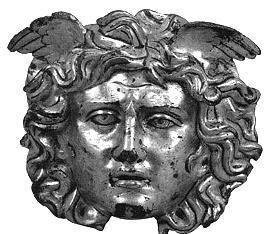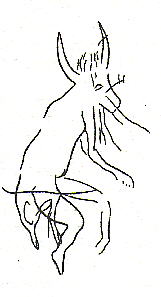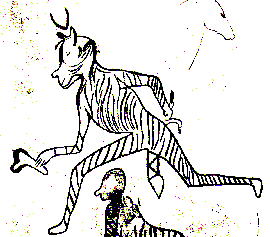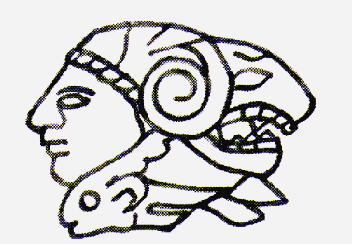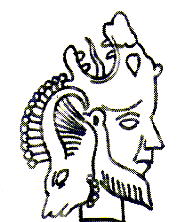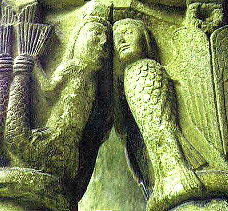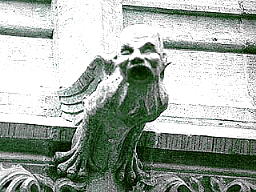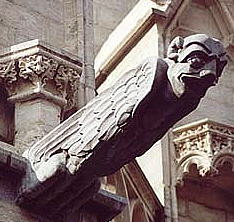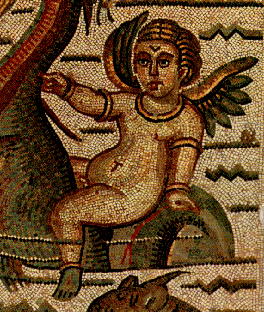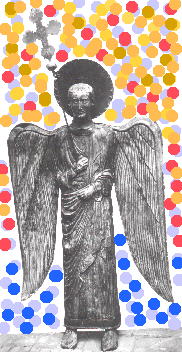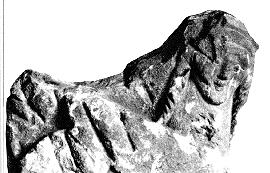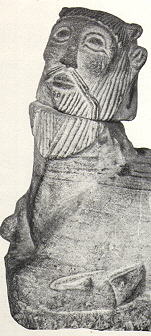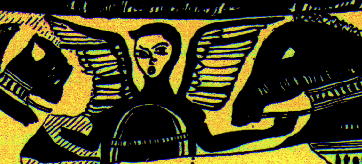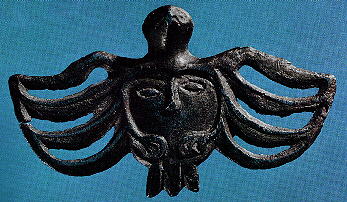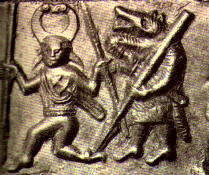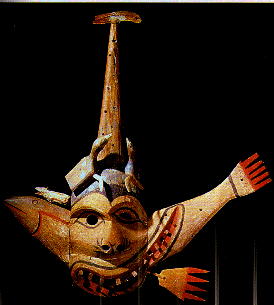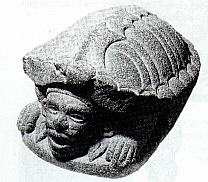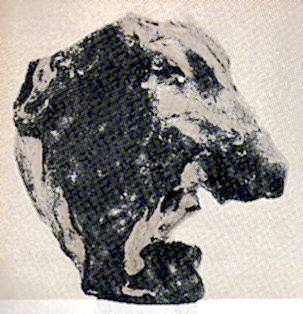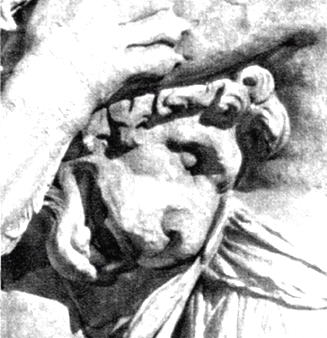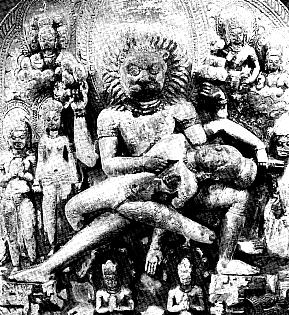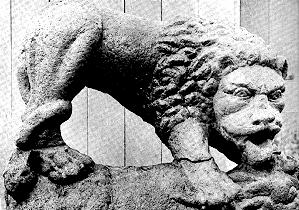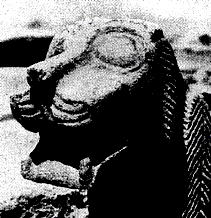Xenophanes of Kolophon (565-470 B.C)
" Not all the things since the beginnings the gods did not reveal to the men
but with the time trying they go finding the best. "
Metamorphoses, book I
"... the goddess said: " Going via away from the temple ,
veil your head, come undone your vestments
and behind your back throw"the boneses of the great mother ".
Along it was their dismay...
But suddenly the son of Promètheus cheers up his spouse
with these quiet words: " Or I am mistaken or just
is the oracle and it induces not us in sacrilege.
The great mother is the earth; as boneses I think she means
the stones of her body: these we must cast behind".
...obeying, stones behind they launch on their steps.
And the stones (who would believe it if did not attest the ancient time to it?)
began to lose their rigid hardness,
to supply little little into softness and, softened, taking shape.
as if they wAges rough-hewn
in the marble, in all similar to just begun statues.
Then, when they grew and more ductile made theyr nature,
it was possible in these to see human shapes,
still imperfect, as if they wAges sketched
in the marble, in all similar to statues as soon as begun...
And in short time, for wanting of the gods, the stones
which the hand of the man threw assumed the aspect of men,
while from the launch of the woman the woman renewed. "
Hybrid and places of the hybrid
Iconography of the hybrid
The wonderful narrations
The ethnography
The most ancient evidences in sculpture
HYBRID AND PLACES OF THE HYBRID
The topic of the transformation, in the positive and in he negative, crosses all the history of the becoming human.
From a transformation, exactly, creation and re-creation of the man happen, as the passage between the following Ages, as attested by the splendid verses of the Metamorphoses of Ovid, in the episode of Deucalion and Pyrrha, in which it speaks about deluge (the Greeks mentioned three following destructions) and stones, skeleton of the Mother Earth.
Without transformation, it cannot be development.
The history, is also, as Vico said, understood with its repeating itself, is fruit of continuous transformations, which often are materialized in symbols, vehicle of the same transformation.
Often the content of such symbols is dark to those same people that make appeal to them, conveying phylogenetic and ontogenetic contents that have become, or have always been, unconscious.
Symbol derives from the Greek verb sùmbolon, that means to interlace, stirring together, as it happens in meeting of waters, the obvious and the hidden, and the hidden can be caught up only through that it is looked at, therefore the meant and its expression, the symbol, exactly.
Every symbol possesses two or more meant.
It belongs to the mental order, and to the semantic one, even if it is not of pertinence of the rational neither of the language, but rather of the perceptive sensorial sphere, the first present in the human being.
The hybrid (from the Latin hybrida, crossing between races or different social conditions) is an arbitrary juxtaposition of various elements, animate and/or inanimate.
A hybrid marks always a passage, from a given shape, existing in nature, to an other, that " contaminates " the first, leaving from the same imaginary of the man.
The dream is one of the first privileged places of the hybrid.
Meaningfully, near the Egyptians, dream meant to be awake, but also to wake up, that is to approach to another truth.
In the 100 A.D., in the Insinger Papyrus, it is written: " The God has created the dreams in order to indicate the way to which sleeps, the eyes of which are in the dark " (obvious connection with the practical of the incubatio, from the Latin incubare, that means to sleep in a place, tied to the cult of the ctonians gods).
The dream offers contaminations coming directly from the unconscious, masked shapes in which the censorship practices, with which the director of scene of the great theatre of the dream camouflages his personages in order to concur they to come into the limelight.
Substitutions and contaminations are to the service of the condensation, that is one of the first mechanisms of the dream identified one hundred years ago by Sigmund Freud (The Interpretation of the dreams , 1900).
The affect that invests the symbol is removed, and who makes use of the symbol nearly always ignores the more hidden meant of it .
However we can assume that, in origin, the symbol flowed out, just like a spring of water from which flows a source, from the ideas and the deeper, even though unconscious interests, of the man, those regarding himself, above all like corporeity, and own the more straits relatives, the birth, the sexuality and the death.
It is matter of unconscious, in how much the basic emotional movement is, for definition, undifferentiated, without direction, just a movement of an energy that presses in order to exit in thousands, appropriate, free rivulets.
Therefore, protect from the repression, the human mind of our ancestors put in relationship two or more ideas, creating the symbol, expressed in the representative language of the art. We discover today already from the beginnings the same, wherever the Paleolithic man has gone and lived, like then has always happened, also in reference to times, spaces and different cultural families.
Already Freud thought that initially there was a conceptual and linguistic identity with regard to that today is connected symbolically.
Sure, to the beginning, the man must have grasped with simplifying and deprived of superstructures immediacy the " likenesses " between two objects/ideas, moreover useful operation to the aim of a fast assimilation of new experiences, likenesses that then could be interlaced together from the symbol.
ICONOGRAPHY OF THE HYBRID
The iconography of the " wonderful ", of the monstrum like wonder, manifestation of something of extraordinary, often of divine, that can provoke both reverent disay and horror, in particular of the being half man and half animal, finds a fertile land in the imaginary of the man: from the first inhabitants of the caves until the inhabitants of the orbiting stations of our millennium, the world of the movies, video, comic strips, video games and toys swarms of hybrid beings, currently in great part inspired to the iconography of the past times, enriched from cybernetics inventions and from the suggestions of the same scientific experimentation.
Recently, Christopher Chippindale, of the Museum of Archaeology and Anthropology of Cambridge University, with Paul Tacon of the Australian Museum in Sydney, has remembered the antiquity of such representations in painting, of which the, Chauvet Cave is a rich example in France, dated 30,000 years ago.
On purpose of the meant of these hybrid figures, G.H.Luquet postulated two interpretations, that are not excluded each other: " beings conceived like having a nature in the same time animal and human, that is divinities, or men covered of an animal camouflage correspondent to some ceremonial practices that, as the ethnographic parallelisms say to us, had according to every likelihood a magical-religious character " (Luquet, 1926).
To wear a mask, like as an example in a recording of the Madeleine, pebble with a male figure and on the head a mask very well drawn, to magical scope, according to Luquet, could have contribute to the belief in hybrid divine beings, with supernatural powers like postulated for the shamans.
Really, the representation of the hybrids half man and half animal, most frequent in historical age, has beginning very previously to the Magdalenian representations in cave.
It is probable that the meant one of these contaminations goes led back to the ritual use of the representation, and beginning from such origin then finds in all the times and all the cultures.
Such type of representation, as we will see, initially is well represented from the sculpture in stone of the lower Paleolithc, " bones of the mother Earth ", activated from the human creativity nourished from the energy of the unconscious. Subsequently, recordings and paintings in cave plentifully testify the existence of these contaminations.
A being half man and half animal leads back to an idea of supernatural, wants for the dimensions, wants for the absolutely unusual aspect.
It must however distinguish that, generally, the hybrid with religious character has positive characters, differently from what happens for the frightful myth.
In the classic mythology, the progeny of Echydna, monstrous woman with the lower part of the body like a snake, and Thypheus, constitutes a rich repertoire of monsters, beginning from Sphinx, face of woman or man on lion body, continuing then with the Harpies, the Hydra of Lerna, the Chimera, Ladon and the Nemean Lion.
The mythical guardians of the garden of the Hesperides, the Gorgons, (Fig.1) had on the head snakes, tusks of wild boar going out from the lips, brazen hands and golden wings.
